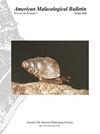Description of Pyropelta elongata sp. nov. (Gastropoda, Pyropeltidae) from a Methane Seep Area in the South China Sea.
IF 0.4
4区 生物学
Q4 MARINE & FRESHWATER BIOLOGY
引用次数: 5
Abstract
Abstract: The genus Pyropelta McLean & Haszprunar, 1987 is exclusively restricted to deep-sea chemosynthesis-based environments, that range from the Western and Eastern Pacific to West Africa. In the present study, a new species, Pyropelta elongata sp. nov., collected from a methane seep area in South China Sea is described and illustrated. The generic assignation is mainly based on shell and radula characters. Pyropelta elongata sp. nov. is characterized by relatively large, elongate shell with a low profile and has a radula formula of (ca. 20)+5+1+5+(ca. 20). These features can distinguish the new species from other congeners.南海甲烷渗漏区长叶火螺(腹足目,火螺科)描述。
摘要/ Abstract摘要:Pyropelta McLean & Haszprunar, 1987属仅局限于以化学合成为基础的深海环境,范围从西太平洋和东太平洋到西非。本文报道了在南海甲烷渗漏区发现的一种新种——长形焦蕨(Pyropelta elongata sp. nov.)。通用赋值主要是基于壳字符和radula字符。长叶火椒(Pyropelta elongata sp. 11 .)的特征是相对较大的、细长的、低轮廓的壳,其半径公式为(约20)+5+1+5+(约20)。20)。这些特征可以将新物种与其他同类区分开来。
本文章由计算机程序翻译,如有差异,请以英文原文为准。
求助全文
约1分钟内获得全文
求助全文
来源期刊
CiteScore
1.00
自引率
40.00%
发文量
1
审稿时长
>12 weeks
期刊介绍:
The American Malacological Bulletin serves as an outlet for reporting notable contributions in malacological research. Manuscripts concerning any aspect of original, unpublished research,important short reports, and detailed reviews dealing with molluscs will be considered for publication. Recent issues have included AMS symposia, independent papers, research notes,and book reviews. All published research articles in this journal have undergone rigorous peer review, based on initial editor screening and anonymous reviewing by independent expertreferees. AMS symposium papers have undergone peer review by symposium organizer, symposium participants, and independent referees.

 求助内容:
求助内容: 应助结果提醒方式:
应助结果提醒方式:


